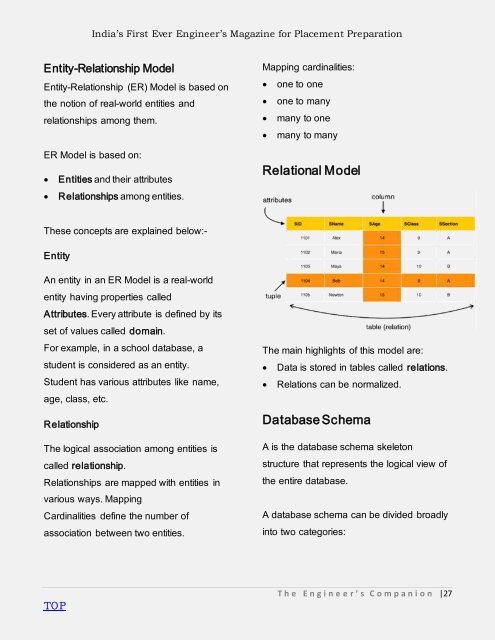The Engineer's Companion-October Magazine Edition
You also want an ePaper? Increase the reach of your titles
YUMPU automatically turns print PDFs into web optimized ePapers that Google loves.
India‟s First Ever Engineer‟s <strong>Magazine</strong> for Placement Preparation<br />
Entity-Relationship Model<br />
Entity-Relationship (ER) Model is based on<br />
the notion of real-world entities and<br />
relationships among them.<br />
ER Model is based on:<br />
Entities and their attributes<br />
Relationships among entities.<br />
Mapping cardinalities:<br />
one to one<br />
one to many<br />
many to one<br />
many to many<br />
Relational Model<br />
<strong>The</strong>se concepts are explained below:-<br />
Entity<br />
An entity in an ER Model is a real-world<br />
entity having properties called<br />
Attributes. Every attribute is defined by its<br />
set of values called domain.<br />
For example, in a school database, a<br />
student is considered as an entity.<br />
Student has various attributes like name,<br />
age, class, etc.<br />
Relationship<br />
<strong>The</strong> logical association among entities is<br />
called relationship.<br />
Relationships are mapped with entities in<br />
various ways. Mapping<br />
Cardinalities define the number of<br />
association between two entities.<br />
<strong>The</strong> main highlights of this model are:<br />
Data is stored in tables called relations.<br />
Relations can be normalized.<br />
Database Schema<br />
A is the database schema skeleton<br />
structure that represents the logical view of<br />
the entire database.<br />
A database schema can be divided broadly<br />
into two categories:<br />
TO P<br />
T h e E n g i n e e r ’ s C o m p a n i o n |27


